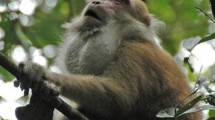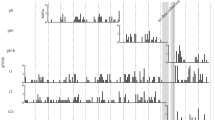Abstract
Feeding conditions, competitive regime, and female social relationships of Japanese macaques (Macaca fuscata) on Yakushima were compared between the two habitats at two different altitudes (coniferous forest, 1,000–1,200 m and coastal forest, 0–200 m). Fruit availability was higher in the coastal forest. There was no consistent difference in the frequency of agonistic interactions within a group during feeding between the two habitats. The coastal forest evoked stronger inter-group contest competition compared to the coniferous forest as evidenced by a higher inter-group encounter rate and a higher proportion of aggressive encounters to non-aggressive ones. Birth rate was higher in larger groups compared to smaller ones in the coastal forest, but did not differ in the coniferous forest. In spite of these differences in competitive regime, no variation in female social relationships was observed, such as direction and concentration on particular individuals in grooming, linearity in dominance rank, counter-attack, and support of juvenile kin during agonistic interactions. The present results indicate that the female social relationships of Japanese macaques are robust and do not change according to changes in the current environment.


Similar content being viewed by others
Change history
26 February 2021
A Correction to this paper has been published: https://doi.org/10.1007/s10329-021-00893-y
References
Agetsuma N (1995) Foraging strategies of Yakushima macaques (Macaca fuscata yakui). Int J Primatol 16:595–609
Barton RA, Byrne RW, Whiten A (1996) Ecology, feeding competition and social structure in baboons. Behav Ecol Sociobiol 38:321–329
Boinski S, Sughrue K, Selvaggi L, Quatrone R, Henry M, Cropp S (2002) An expanded test of the ecological model of primate social evolution: competitive regimes and female bonding in three species of squirrel monkeys (Saimiri oerstedii, S. boliviensis, and S. sciureus). Behaviour 139:227–261
Cords M (2002) Friendship among adult female blue monkeys (Cercopithecus mitis). Behaviour 139:291–314
Di Fiore A, Rendall D (1994) Evolution of social organization: a reappraisal for primates by using phylogenetic methods. Proc Natl Acad Sci USA 91:9941–9945
Enquist M, Plane E, Röed J (1985) Aggressive communication in fulmars (Fulmarus glacialis) competing for food. Anim Behav 33:1007–1020
Fooden J, Aimi M (2003) Birth-season variation in Japanese macaques, Macaca fuscata. Primates 44:109–117
Furuichi T (1984) Symmetrical patterns in non-agonistic social interactions found in unprovisioned Japanese macaques. J Ethol 2:109–119
Hanya G (2004a) Diet of a Japanese macaque troop in the coniferous forest of Yakushima. Int J Primatol 25:55–71
Hanya G (2004b) Seasonal variations in the activity budget of Japanese macaques in the coniferous forest of Yakushima: effects of food and temperature. Am J Primatol 63:165–177
Hanya G, Noma N, Agetsuma N (2003a) Altitudinal and seasonal variations in the diet of Japanese macaques in Yakushima. Primates 44:51–59
Hanya G, Yoshihiro S, Zamma K, Kubo R, Takahata Y (2003b) New method to census primate groups: estimating group density of Japanese macaques by point census. Am J Primatol 60:43–56
Hanya G, Yoshihiro S, Zamma K, Matsubara H, Ohtake M, Kubo R, Noma N, Agetsuma N, Takahata Y (2004) Environmental determinants of the altitudinal variations in relative group densities of the Japanese macaques on Yakushima. Ecol Res 19:485–493
Hanya G, Kiyono M, Yamada A, Suzuki K, Furukawa M, Yoshida Y, Chijiiwa A (2006) Not only annual food abundance but also fallback food quality determines the Japanese macaque density: evidence from seasonal variations in home range size. Primates 47:275–278
Hayaishi S, Kawamoto Y (2006) Low genetic diversity and biased distribution of mitochondrial DNA haplotypes in the Japanese macaque (Macaca fuscata yakui) on Yakushima Island. Primates 47:158–164
Henzi SP, Barrett L (1999) The value of grooming to female primates. Primates 40:47–59
Hill DA, Agetsuma N (1995) Supra-annual variation in the influence of Myrica rubra fruit on the behavior of a troop of Japanese macaques in Yakushima. Am J Primatol 35:241–250
Hill DA, Okayasu N (1995) Absence of ‘youngest ascendancy’ in the dominance relations of sisters in wild Japanese macaques (Macaca fuscata yakui). Behaviour 132:367–379
Isbell LA (1991) Contest and scramble competition: patterns of female aggression and ranging behavior in primates. Behav Ecol 2:143–155
Isbell LA, Young TP (2002) Ecological models of female social relationships in primates: similarities, disparities, and some directions for future clarity. Behaviour 139:177–202
Izar P (2004) Female social relationships of Cebus apella nigritus in a southeastern Atlantic forest: an analysis through ecological models of primate social evolution. Behaviour 141:71–99
Johnson CA, Grant JWA, Giraldeau L-A (2004) The effect of patch size and competitor number on aggression among foraging house sparrows. Behav Ecol 15:412–418
Koenig A, Beise J, Chalise MK, Ganzhorn JU (1998) When females should contest for food: testing hypotheses about resource density, distribution, size, and quality with Hanuman langurs (Presbytis entellus). Behav Ecol Sociobiol 42:225–237
Koenig A (2002) Competition for resources and its behavioral consequences among female primates. Int J Primatol 23:759–783
Korstjens AH, Sterck EHM, Noë R (2002) How adaptive or phylogenetically inert is primate social behaviour? A test with two sympatric colobines. Behaviour 139:203–225
Matsubara M, Sprague DS (2004) Mating tactics in response to costs incurred by mating with multiple males in wild females Japanese macaques. Int J Primatol 25:901–917
Matsumura S (1999) The evolution of “egalitarian” and “despotic” social systems among macaques. Primates 40:23–31
Mitani JC, Rodman PS (1979) Territoriality: the relation of ranging pattern and home range size to defendability, with an analysis of territoriality among primate species. Behav Ecol Sociobiol 5:241–251
Mitchell CL, Boinski S, van Schaik CP (1991) Competitive regimes and female bonding in two species of squirrel monkeys (Saimiri oerstedi and S. sciureus). Behav Ecol Sociobiol 28:55–60
Nakagawa N (2007) Despotic wild patas monkeys (Erythrocebus patas) in Kala Maloue, Cameroon. Am J Primatol: doi:10.1002/ajp.20481 (in press)
Saito C, Sato S, Suzuki S, Sugiura H, Agetsuma N, Takahata Y, Sasaki C, Takahashi H, Tanaka T, Yamagiwa J (1998) Aggressive intergroup encounters in two populations of Japanese macaques (Macaca fuscata). Primates 39:303–312
van Schaik CP (1989) The ecology of social relationships amongst female primates. In: Standen V, Folley RA (eds) Comparative socioecology. Blackwell, Oxford, pp 195–218
van Schaik CP, Kappler PM (1996) The social systems of gregarious lemurs:lack of convergence with anthropoids due to evolutionary disequilibrium? Ethology 102:915–941
van Schaik C, van Hooff JARAM (1983) On the ultimate causes of primate social systems. Behaviour 85:91–117
Schülke O (2003) To breed or not to breed-food competition and other factors involved in female breeding decisions in the pair-living nocturnal fork-marked lemur (Phaner furcifer). Behav Ecol Sociobiol 55:11–21
Seyfarth RM, Cheney DL (1984) Grooming, alliances and reciprocal altruism in vervet monkeys. Nature 308:541–543
Shopland JM (1987) Food quality, social deployment, and the intensity of feeding interference in yellow baboons (Papio cynocephalus). Behav Ecol Sociobiol 21:149–156
Sterck EHM, Watts DP, van Schaik CP (1997) The evolution of female social relationships in nonhuman primates. Behav Ecol Sociobiol 41:291–309
Sugiura H, Saito C, Sato S, Agetsuma N, Takahashi H, Tanaka T, Furuichi T, Takahata Y (2000) Variation in intergroup encounters in two populations of Japanese macaques. Int J Primatol 21:519–535
Sugiura H, Agetsuma N, Suzuki S (2002) Troop extinction and female fusion in wild Japanese macaques in Yakushima. Int J Primatol 23:69–84
Takahata Y, Suzuki S, Okayasu N, Sugiura H, Takahashi H, Yamagiwa J, Izawa K, Agetsuma N, Hill D, Saito C, Sato S, Tanaka T, Sprague D (1998a) Does troop size of wild Japanese macaques influence birth rate and infant mortality in the absence of predators? Primates 39:245–251
Takahata Y, Suzuki S, Agetsuma N, Okayasu N, Sugiura H, Takahashi H, Yamagiwa J, Izawa K, Furuichi T, Hill DA, Maruhashi T, Saito C, Sato S, Sprague DS (1998b) Reproduction of wild Japanese macaque females of Yakushima and Kinkazan islands: a preliminary report. Primates 39:339–349
Weir LK, Grant JW (2004) The causes of resource monopolization: interaction between resource dispersion and mode of competition. Ethology 110:63–74
Yamagiwa J, Hill D (1998) Intraspecific variation in the social organization of Japanese macaques: past and present scope of field studies in natural habitats. Primates 39:257–273
Acknowledgments
This study would not have been possible without help from the members of “Yakuzaru-Chosatai” (Yakushima Macaque Research Group) who voluntarily joined the censuses. We would like to thank our friends and colleagues in Yakushima for their hospitality and help. Dr. C. P. van Schaik, reviewers and the editor of this journal and the staff at the Primate Research Institute, Kyoto University (KUPRI), gave us helpful suggestions on the manuscript. The Yakushima Forest Environment Conservation Center gave us permission to conduct the research. The Sarugoya Committee and Field Research Center of KUPRI offered us excellent facilities. We are grateful to these people and organizations. This study was financed by the Cooperation Research Program of KUPRI, MEXT Grant-in-Aid for JSPS Fellows, 21st Century COE Program (A14) and Global COE Program “Formation of a Strategic Base for Biodiversity and Evolutionary Research: from Genome to Ecosystem”.
Author information
Authors and Affiliations
Corresponding author
About this article
Cite this article
Hanya, G., Matsubara, M., Hayaishi, S. et al. Food conditions, competitive regime, and female social relationships in Japanese macaques: within-population variation on Yakushima. Primates 49, 116–125 (2008). https://doi.org/10.1007/s10329-007-0073-y
Received:
Accepted:
Published:
Issue Date:
DOI: https://doi.org/10.1007/s10329-007-0073-y




